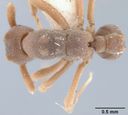Cyphomyrmex
Cyphomyrmex
Classification
- Phylum: Arthropoda
- Subphylum: Hexapoda
- Class: Insecta
- Order: Hymenoptera
- Superfamily: Formicoidea
- Family: Formicidae
- Subfamily: Myrmicinae
- Tribe: Attini
- Subtribe: Attina
- Genus: Cyphomyrmex
Pronunciation
How to pronounce Cyphomyrmex: /ˌsaɪfoʊˈmɜrmɛks/
These audio files are automatically generated. While they are not always 100% accurate, they are a good starting point.
Images






Summary
Cyphomyrmex is a genus of small, cryptic fungus-growing ants primarily found in South and Central America, known for their unique yeast gardens cultivated from fungi in the tribe Leucocoprineae. Colonies are relatively small, monogynous, and host a specialized relationship with their fungal gardens.
Physical Characteristics
The frontal carinae on the head form a shield, which is quite diagnostic for this genus. There are blunt tubercles lining the mesosoma. Species are divided into two complexes: strigatus (six or more teeth on mandibles) and rimosus (five teeth on mandibles).
Identification Tips
Look for the unique frontal carinae and the number of teeth on the mandibles to distinguish between the strigatus and rimosus complexes.
Habitat
Common nest sites include soil, under rotting logs, within hollow and dead twigs. Some species create swallow nest-like structures made of soil or clay that hang underneath overhangs. They can inhabit both moist and arid environments.
Distribution
Primarily found in South and Central America, with some species in the southern portion of North America, extending from Texas to California and east to Florida.
Diet
Primarily mycophagous, especially in larval stages. Workers also consume sugary substances obtained from foraging.
Life Cycle
Undergo complete metamorphosis, with larvae groomed by workers to promote fungal growth on their integument. Workers age out of nursing roles into foraging.
Reproduction
Typically monogynous colonies with a founding queen relying on fungal gardens for nutrients for the first generation of workers.
Predators
Specialized wasps in the family Diapriidae parasitize larvae and can lead to a significant mortality rate.
Ecosystem Role
Fungus cultivators that maintain a symbiotic relationship with the fungi they manage, contributing to nutrient cycling in their ecosystems.
Evolution
More basal within the phylogenetic relationship of attine ants, with a sister relationship to Mycetophylax.
Tags
- fungus-growing ants
- attine
- Myrmicinae
- Cyphomyrmex